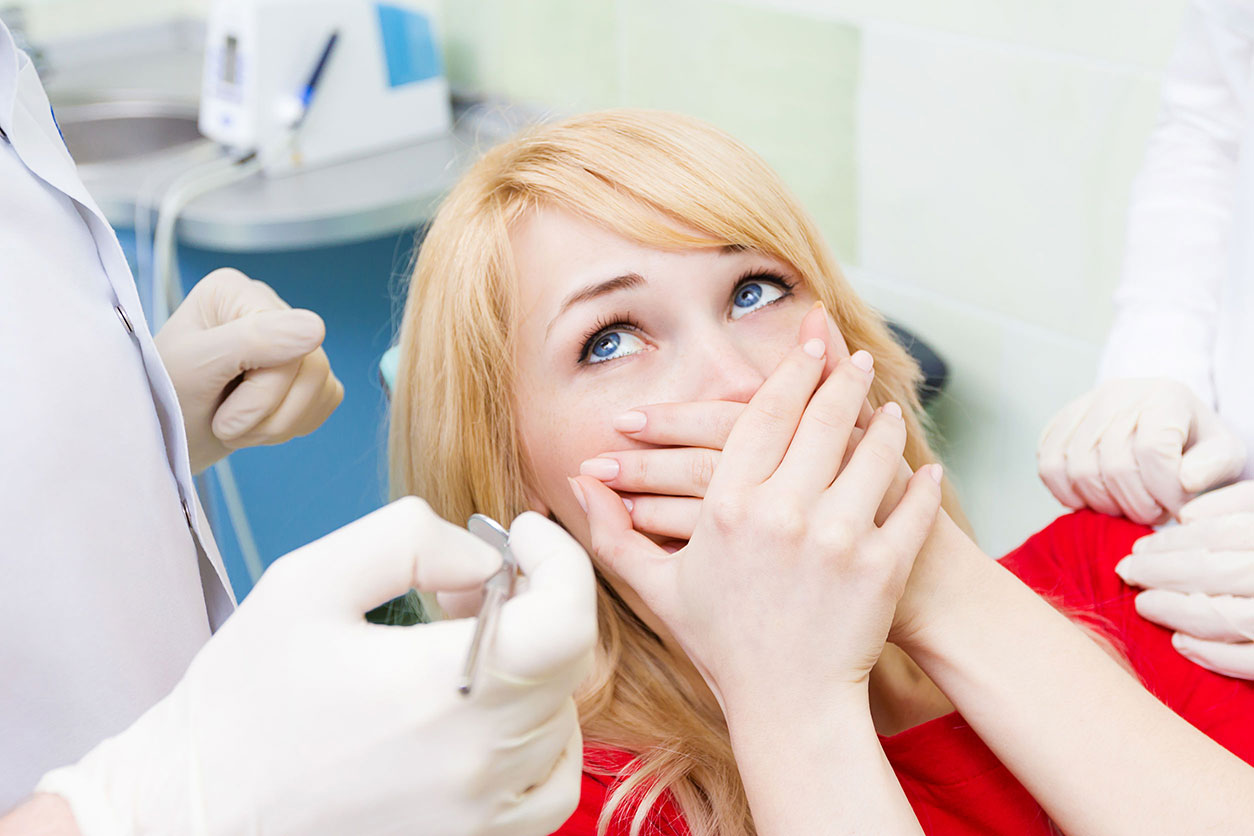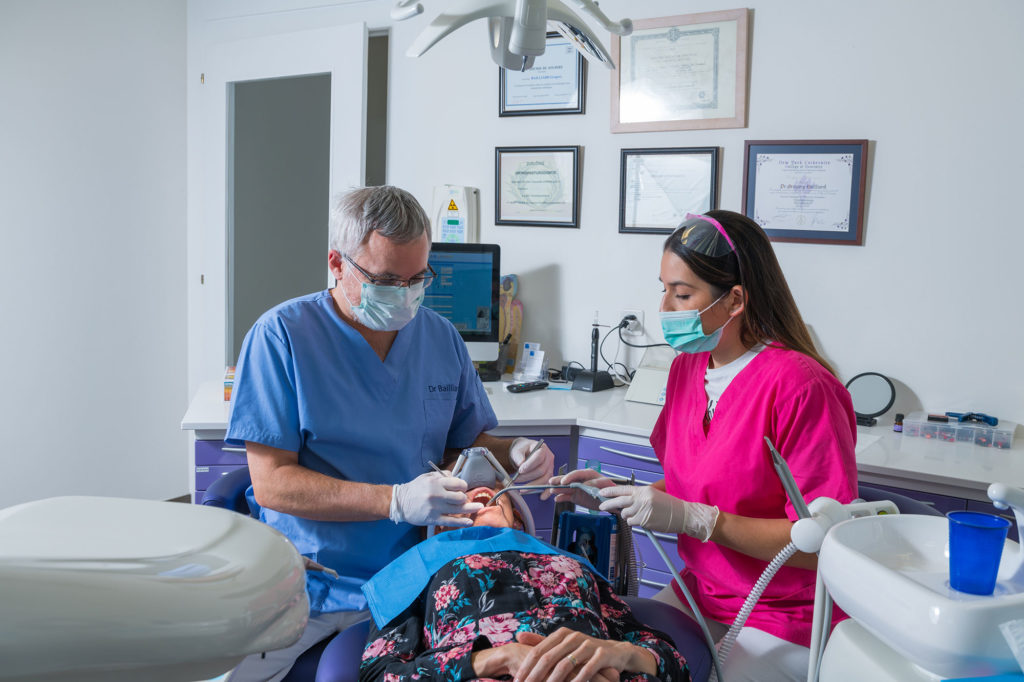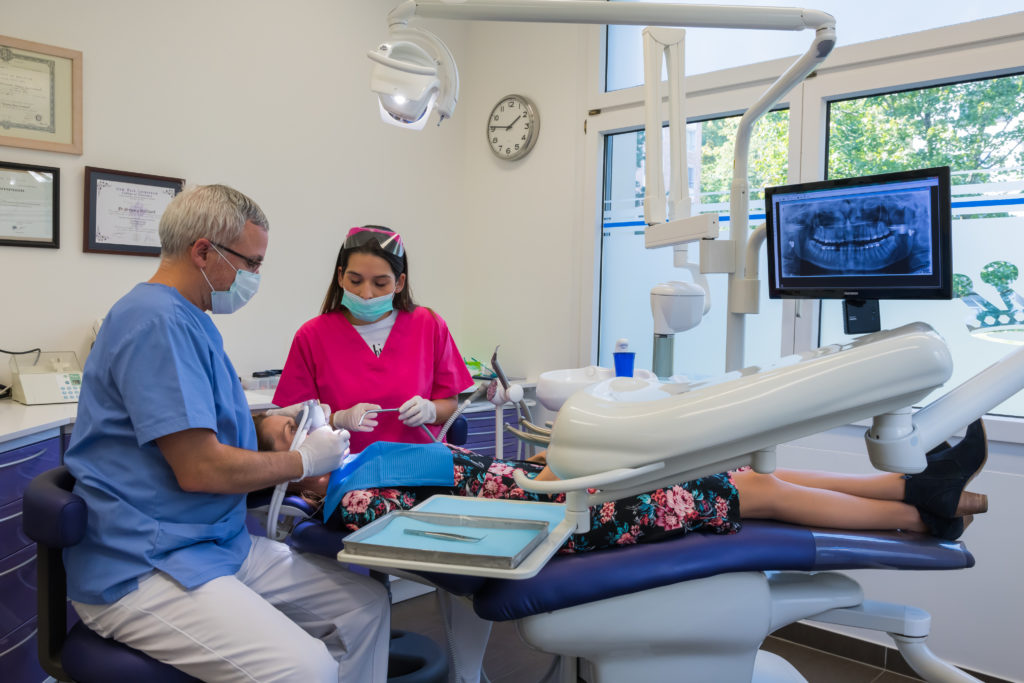
Don't be afraid of the dentist anymore
Managing anxiety
Who doesn't know that little pinch in the stomach just before going to the dentist? About 30% of the population says they feel apprehensive before going to the dentist. Traumatic experiences in childhood are sometimes at the root of this phobia, which can manifest itself through heart rate increases, sweating, high heart rate, but also through insomnia the night before the appointment. The Champel Dental Centre will help you to manage your anxiety before each appointment.
Dentist phobia is often a primitive, inexplicable fear. The fact that today's dentist "doesn't hurt anymore" is often not very helpful for people affected by this phenomenon, who are often not taken seriously with their anxiety.
The vehement refusal, linked to this apprehension, to go to the dentist can have catastrophic consequences on the dental condition as well as on the general physical and psychic state.
Treatment of anxious patients
In our practice, we offer special treatment methods that are tailored to the needs of these patients and which have proven their worth.
We have two objectives when treating phobic patients:
- to achieve optimal dental cleansing of the patient without stress or anxiety.
- overcome the patient's fear and suppress it in a lasting way.
To achieve this goal, we have been using a strategy for several years that has proven to be very effective and focuses on the following themes: confidence building, lack of stimulation, gentle and stress-free treatments, interactive discussion of sessions
Confidence building
Many of the dentist's phobic patients report that in the past they have been traumatized by a breakdown in trust with the dentist. This situation can go back several years, following treatment by an insensitive or brutal dentist. A promise made lightly by the dentist ("it's not going to hurt..."), and then not kept, can destroy trust and ultimately be traumatic.
We therefore understood that the dental treatment of anxious patients could only succeed if the patient had full confidence in his practitioner and his team. He expects not only a job well done, but also clear and reliable information about the treatment, and some attention, patience and understanding for the anxiety he feels.
Thus, despite the hectic pace of the practice's daily routine, our team has a high level of patience, is armed with the necessary psychological tools, and has acquired with experience a great deal of intuition to grasp the patient's anxieties and thereby gain his confidence.
Lack of stimulation
Due to past experiences, the dental practice represents a risky place for the anxious patient: we therefore take adequate precautions to minimize anxiety-provoking stimuli :
Our cabinets are bright, spacious and bathed in light. Noise pollution from the practice as well as conventional odours are avoided in the waiting area.
We make every effort to be punctual and thus reduce anxiety-inducing waiting times as much as possible. We have a varied and renewed reading to distract the patient.
Gentle and stress-free treatments
Gentle, pain-free treatment should be a matter of course today, and not only for anxious patients.
The effectiveness of local anaesthesia has progressed so much that dental treatments, such as more extensive procedures, can be performed absolutely painlessly. An anaesthesia technique and equipment adapted to each situation, allows for rapid and satisfactory results in all cases, minimising the pain of needle insertion as much as possible.
Our staff are trained to perform "gentle" treatments and are sensitive enough to recognize patients' needs in time, for example when the patient wants to take a break during treatment or rinse their mouth.
General anaesthesia at the dental centre
General anaesthesia is possible in the case of heavy surgery, long operations or for disabled patients or those with certain pathologies.
This type of anesthesia renders the patient unconscious and insensitive to pain. The procedure can last up to 2 hours for children and 4 hours for adults. A rest period of about 45 minutes follows. The patient must always be accompanied, and remain so throughout the day.


Conscious sedation
However, for most patients suffering from dental phobia, not all of these measures are sufficient to overcome their often extreme fear of the dentist in the beginning. Experience has shown us that conscious sedation with nitrous oxide represents an ideal complement to the measures mentioned above.
The term sedative or sedation is Latin for "tranquilize". It means to soothe the nervous system with medication, causing the patient to become drowsy. The degree of sedation can range from mild sedation to deep drowsiness. Consciousness, spontaneous breathing and protective reflexes remain active.
Medical treatments that the patient feels uncomfortable or painful, such as gastroscopy, are often performed under conscious sedation. Sedatives have also found their place in dentistry and represent an alternative to treatment under general anaesthesia.
There are essentially two types of sedation used in anxious patients:
- Sedation by inhalation of nitrous oxide
- Medicated sedation with tranquilizers
CONSCIOUS SEDATION WITH NITROUS OXIDE
A patient suffering from dentophobia is treated with laughing gas: he breathes a mixture of nitrous oxide and oxygen through a light mask placed over his nose. He only has to start breathing the mixture to feel a slight tingling in his hands and feet, which indicates that the gas is already starting to take effect. Fear is then replaced by a pleasant feeling of warmth and well-being. The patient is in a kind of trance and no longer perceives what is going on around him. He follows the pleasant and suggestive thread of his thoughts and time passes in the blink of an eye. Sensitivity to pain and unpleasant reflexes such as gagging or swallowing are greatly reduced.
The gas passes through the lungs into the bloodstream and combines with certain receptors in the brain. This is where it acts in three ways:
- Pain relief (analgesia): Treatment with nitrous oxide can significantly raise the pain threshold. The patient barely feels minor pain stimuli. The injection of dental local anaesthesia (the local anaesthetic injection), which under other conditions is often felt as unpleasant, can be administered, for example, without the patient feeling pain. Although sedation with laughing gas cannot replace local anesthesia, less local anesthesia is needed than in a patient who is not under sedation due to the analgesic or analgesic (pain-relieving) effect of laughing gas.
- Anti-anxiety effect (anxiolysis): In most patients with dentophobia, sedation with laughing gas clearly calms the anxiety (anxiolytic effect). The initial fear and tension gives way to a comfortable trance-like state, which also makes it easier to endure long and strenuous treatments. As laughing gas stimulates the flow of pleasant thoughts and imagination, the duration of the treatment seems shorter to the patient from a subjective point of view.
- Anti-nausea (anti-emetic) effect: headaches and nausea are common problems encountered during dental treatment, especially in cases of dental phobia. During a nitrous oxide sedation, the nausea reflex is greatly reduced. Even procedures that are more difficult to bear, such as an impression or an X-ray at the back of the mouth, are thus possible without causing nausea. When the gag reflex is particularly important, the nitrous oxide can also be combined with an antiemetic (anti-vomiting) medication.
Advantages of nitrous oxide
A great advantage of laughing gas sedation is the optimal control of the procedure: the anti-anxiety effect starts as soon as it is breathed in and the depth of sedation can be influenced at any time by changing the ratio of the ptotoxide/oxygen mixture. At the end of the treatment, the supply of monoxide is stopped and the patient breathes pure oxygen for a few minutes.
Because laughing gas is not metabolized, it is rapidly exhaled and completely eliminated from the body. The "hang-over" effect of other tranquilizers, which remain in the bloodstream for longer periods of time and still take effect hours later, does not exist with nitrous oxide. In contrast to other sedation methods, the patient is then able to leave the practice alone and without an accompanying person. In the United States, where liability laws are particularly strict, the patient is even allowed to drive home after waiting 15 minutes. However, after treatment with laughing gas, we recommend using public transportation for safety reasons.
Another particularly crucial advantage is the reliability of the procedure, which, if applied properly, causes almost no side effects, apart from the nausea that may occur occasionally. Laughing gas has been used in medicine for more than 150 years, which is why it is one of the best-studied sedatives. Scientific studies of several million documented applications by dentists in the United States have revealed no fatalities or health hazards, making laughing gas the safest form of sedation in dentistry.
DRUG SEDATION
Other drug-based sedative procedures have become established in dentistry, offering a proven alternative to laughing gas. These are generally active ingredients from the benzodiazepine or antihistamine groups, which have been used for decades as tranquilizers. The best-known preparation is :
- Atarax® (active ingredient: Hydroxyzine)
Atarax, which is easier to control and metabolized within a few hours, has become increasingly popular in recent years. In our practice, we have been treating anxious patients (dental phobia / oral phobia) with Atarax sedation for many years, although in some cases we also administer nitrous oxide.
Atarax initially causes a calming of anxiety (anxiolysis) accompanied by a pronounced relaxation of the muscles and a slight euphoric effect. A higher dosage leads to drowsiness: the patient is no longer aware of what is going on around him or her and hardly reacts when spoken to. In this phase, the treatment goes smoothly.
The disadvantage of this method is that, due to the residual effect (hang-over) of the drug, Atarax patients always need an accompanying person (even when using public transport) to be able to go home. Driving is allowed only 12 hours after the procedure.
Security
Sedatives, which have been used for decades, are very safe and have few side effects, provided they are applied appropriately and by an experienced practitioner. The correct dosage is not easy to achieve, as it must be adapted to each individual patient. Some patients need a very high dose to achieve sufficient sedation, while for others half is enough to put them into a deep sleep.
Homeopathy and alternative medicine
In some cases, we avoid medicines in favour of essential oils. Not only are they natural, but they also replace traditional pharmacopoeia very advantageously. They are very effective and heal at different levels. For eugenol, for example, which is in fact clove essence, it disinfects, immediately soothes the pain with, as a bonus, a "vitalizing" effect for the tooth which will boost immunity and fight against devitalization. We also use orchid essences or homeopathy to help patients relax.
HYPNOSIS
Modern hypnosis has nothing to do with the great hypnotising mages putting their subjects under their control. The patient remains in control and will play a vital role. The goal is to put the mind in a particular state of mental concentration, by mentally visualizing, for example, a pleasant place or situation. Through this thought, the mind becomes indifferent to any other consideration or influence.
This altered state, but always of wakefulness and not of drowsiness, is caused by the therapist, by his voice, for example. It guides the patient, leads him to concentrate on his senses, his body, and this leads to a dissociation of the consciousness allowing access to a privileged communication with the body and the psyche, the unconscious. The person himself can also induce this state, which is why we speak of self-hypnosis.
Hypnosis can be compared to a kind of psychological Swiss army knife: practical, quick to open, transform and heal. Moreover, the tool is easy to carry and can be used at any time.
Hypnosis is effective for many pathologies, but in particular in dentistry we will be interested in its action on the fight against pain, phobias, and smoking cessation (80% success rate).
At the Champel Dental Centre, we work in collaboration with a certified hypnotherapist in Ericksonian and humanistic hypnosis who will be able to help you in the management of your phobias or pain.


